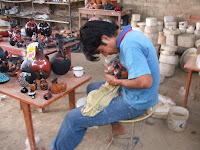 |
| Vicus owl pot I have always been drawn to the art of ancient cultures especially their jewelry and their pottery. In Northern Peru their works are less known but not any less beautiful. |
VICUS peoples (400BC-600AD) were known for their work in ceramics, copper, and gold. Living mainly on the coastal deserts, they used the native clay and local dyes to produce natural and religious symbols; modern day pottery from the town of Chulucanas is said to closely resemble the ancient art. They created Double spout and bridge vessels that created whistling sounds when pouring liquids.
MOCHE potters (100-800AD) produced a great variety of exquisitely decorated vessels. The ceramics incorporated a wide-ranging subject matter, whether the actual form of the pot or the fine line paintings on them, of representations that included people, animals, and gods hunting and making war, music making, visiting rulers, burying the dead, curing the sick, anthropomorphic and ritual scenes. Moche ceramics illustrated all manner of behavior, both human and divine, through expressive modeling and painting, but there were certain reoccurring narrative themes throughout that defined their ideologies.
 |
| Moche pottery- note various themes |
Pottery representing actual people in Moche ceramics is one of the best known art forms from the Andes.The pieces are very realistic, representing specific individuals, most likely that of important people or rulers.These portrait jars depict weaknesses and physical disabilities accurately; a wide variety depicts disfigured individuals and individuals with genetic defects, giving archeologists an insight into this ancient culture. For these ancients, the processes that created disfigurements were treated with respect and the people they affected were considered part of the normal human condition.
CHIMU (900-1470) ceramics are all black. This culture is also known for its exquisite and intricate metal-working, one of the most advanced of pre-Columbian times. Chimú ceramics were crafted for two functions: containers for daily domestic use and those made for ceremonial use for offerings at burials. Domestic pottery was developed without higher finishing, while funeral ceramics showed more aesthetic refinement.
 |
| Chimu llama head pot |
When I was last in Piura, an old woman whose family I knew well, showed me about six pieces that her husband has collected- legally or illeglly, I do not know. She later offered me one, which I took, knowing I would never get it out of the country. I gave it to her daughter to keep for her children, as it is part of their heritage, not mine.
 |
| Inca ceremonial vessel |
THE POTTERS OF CHULUCANAS- The town of Chulucanas is famous for its pottery. Originally dating from pre-Inca times it is today exported all over the world. The potters of the Vicus culture in the coastal deserts of Peru were known throughout the land as the finest ceramic artists. Using the clay beneath their feet, the natural symbols around them and a strong religious inspiration to guide them, they fashioned elegantly shaped, subtly painted ceramic pots. Designs are varied, but are predominated by black and white. There are several bigger companies but a lot of small manufactures are in Chulucanas itself and in the nearby villages of Quatro Esquinas.
 |
| Studio of Maneno- polishing my purchases |
Victor Manuel Juarez is a young artist in search for his own style..." That is what the art critics say about Maneno, but he says he is neither young nor looking for a new style. He is believed to be one with his ancestors that have been making pottery for thousands of years. He is called LLINQA RIMACHIQ "The one that makes the clay speak".
 |
| Maneno |
 |
| One of the kilns at Maneno's |
 |
| Mother & Child & bird with llama from Maneno (OLR Christmas card) |